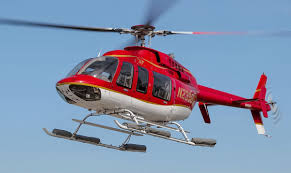Aircraft Technical Data
Bell 407

| Details | |
| Country of Origin | Canada and USA |
| Type | Seven place utility helicopter |
| History | Bell's already popular 407 is the long awaited successor to its JetRanger and LongRanger light singles. Development work on Bell's New Light Aircraft replacement for the LongRanger and JetRanger dates back to 1993. The end result was the 407, an evolutionary development of the LongRanger. A modified 206L3 LongRanger served as the concept demonstrator 407 and first flew in this form on April 21 1994, while the 407 was first publicly announced at the Las Vegas HeliExpo in January 1995. The 407 concept demonstrator mated the LongRanger's fuselage with the tail boom and dynamic system of the military OH58D Kiowa (which has a four blade main rotor). Fake fairings were used to simulate the wider fuselage being developed for the production standard 407. The first preproduction 407 flew in June 1995, the first production 407 flew in November 1995. Customer deliveries commenced the following February. Compared with the LongRanger, the 407 features the four blade main rotor developed for the OH58, which uses composite construction, and the blades and hub have no life limits. Benefits of the four blade main rotor include improved performance and better ride comfort. Another big change over the LongRanger is the 18cm (8in) wider cabin, increasing internal cabin width and space, plus 35% larger main cabin windows. Power is from a more powerful Allison 250C47 turboshaft fitted with FADEC, allowing an increase in max takeoff weight and improving performance at hotter temperatures and/or higher altitudes. The tail boom is made from carbonfibre composites, while Bell has studied fitting the 407 with a shrouded tail rotor. Bell looked at the 407T twin 407 for a time, but opted instead to develop the substantially revised twin PW206D powered 427. |
| Powerplants | One 605kW (814shp) takeoff rated, 520kW (700shp) max continuous rated Allison 250C47 turboshaft driving a four blade main rotor and two blade tail rotor. |
| Performance | Max cruising speed at sea level 237km/h (128kt), max cruising speed at 4000ft 243km/h (131kt), economical cruising speed at 4000ft 213km/h (115kt). Service ceiling 18,690ft. Hovering ceiling in ground effect 12,200ft, out of ground effect 10,400ft. Max range 577km (312nm). Endurance 3hr 42min. |
| Weights | Empty equipped 1178kg (2598lb), max takeoff with internal load 2268kg (5000lb), max takeoff with sling load 2495kg (5500lb). |
| Dimensions | Main rotor disc diameter 10.67m (35ft 0in), length overall rotors turning 12.70m (41ft 8in), fuselage length 9.77m (32ft 1in), height overall 3.56m (11ft 8in). Main rotor disc area 89.4m2 (962.1sq ft). |
| Capacity | Typical seating configuration for seven comprising pilot and passengers, with five passengers in main cabin. Max hook capacity 1200kg (2645lb). |
| Production | 200th 407 delivered in September 1997. Production runs at a rate of over 10 per month. 140 alone built in 1997. |
| Related Links | Bell 407 |
The backbone of this section is from the The International Directory of Civil Aircraft by Gerard Frawley and used with permission. To get your own copy of the book click here. |
|








